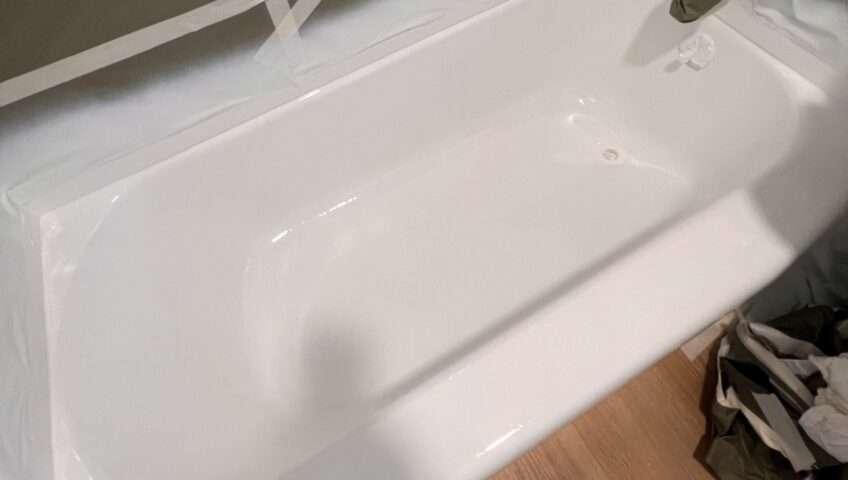Transforming a worn or dated bathtub with paint is a gratifying and cost-effective project. I know because I’ve painted bathtubs in my rental properties and customers’ homes for my home improvement business.
Besides my personal experience, I spoke with the owner of a tub refinishing company and a product manager at Rust-Oleum. If you’ve ever wondered, “Can you paint a bathtub?” keep reading to find the answer and more, including pro tips and recommendations.
Can You Paint a Bathtub?
Yes, but the task requires a specially formulated paint.
“Because bathtubs are constantly exposed to water and moisture, ordinary paints will not work,” says Andrew Zona, a product manager at Rust-Oleum. Instead, you’ll need a high-strength epoxy coating that can withstand a tub’s moisture demands. The job also requires extensive prep before applying the epoxy.
“Bathtubs have a hard, smooth surface that paint won’t stick to,” says Nicholas Coletti, owner of Superior Bathtub Refinishing in Massachusetts. “During prep work, the surface needs to be cleaned, dulled and scuffed without scratching, to create a suitable surface for paint adhesion.”
You can paint your tub yourself or hire a pro like Coletti. Several companies sell bathtub and tile painting kits marketed to homeowners. These come with everything you’ll need from prep to finish, like Rust-Oleum Tub and Tile. These kits, found at most home improvement stores for less than $100, are best for DIYers with at least some painting experience and know-how.
For those who’d rather leave it to the pros, expect an average cost of $480 for labor and materials.
Whether doing it yourself or hiring a pro, refinishing your tub is a budget-friendly way to remodel a bathroom.
“It can cost thousands to have a tub removed, disposed of and have a new tub installed,” says Coletti. “Refinishing is a fantastic way to save money and salvage a perfectly good tub.”
Painting vs. Reglazing a Tub
The terms ‘painting’ and ‘reglazing’ are often used interchangeably, since both entail putting a new finish coat onto the tub surface. For our purposes, we’ll go with ‘painting’ for homeowner kits and ‘reglazing’ for a professionally applied product.
The biggest difference between painting and reglazing a tub? The products used to complete the project. Professionals have access to commercial-grade glazing that forms a stronger bond and harder cured surface than paint products available to homeowners and DIYers.
“I use a two-part epoxy primer with a hardener, then an acrylic polyurethane glaze that also contains a hardener,” Coletti says. He uses an etching compound to chemically abrade the surface, then applies two coats of primer and three coats of topcoat for about six millimeters of coverage.
Conversely, most DIY kits call for a thorough cleaning and offer sandpaper to further prep the surface with no etching agent. The finish coat is a single-part spray paint or a two-part epoxy paint. Most kits call for two coats of coverage.
Even with the product advantage, it’s important to note painting and reglazing are temporary fixes, not permanent solutions. However, professional reglazing will last much longer than a DIY kit. “If done correctly, a reglazed tub can last seven to 15 years before it requires another refinish job,” Coletti says.
Conversely, homeowner kits will last a few years at most, unless the tub is rarely used. Despite this short window, DIY kits offer a low-cost, short-term facelift while you save up for a full bathroom remodel. If you plan to keep your tub and use it often, professional reglazing is worth the extra cost.
Cast-Iron Bathtub
Cast-iron bathtubs are great candidates for refinishing if still in good structural condition. “They’re the best ones to try and save,” Coletti says. “They’re solid and last longer than the newer ones.”
For these, Coletti fills any chips with an industrial resin, then uses an acid etch to abrade the smooth porcelain before priming.
If refinishing yourself, fill in any chips in the porcelain finish with a resin filler like Bondo, then clean and sand the surface of the tub before coating.
Fiberglass Bathtub
Fiberglass is a popular bathtub material as well as a great candidate for refinishing. Coletti likes fiberglass because its softer surface can be sanded. “I can really sand into a fiberglass tub with 220-grit paper and get a nice scuffed surface,” he says. “The paint adhesion is great.”
For DIYers, take care if refinishing a fiberglass tub, because it can be difficult to sand the surface evenly for a smooth finish. Start with 400-grit sandpaper to practice working evenly over the surface of the tub. If in doubt, consider hiring a pro for best results.
Coletti also warns if your fiberglass tub flexes at all, it’s not a good candidate for refinishing. That’s because the coating will fail due to the surface movement. This is also true for retrofitted tub liners.
“Unfortunately, [refinishing] will not work on fitted tub and shower liners because they flex, causing the hard enamel coating to crack,” says Zona.
Source: www.familyhandyman.com


Write a Comment